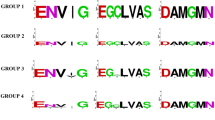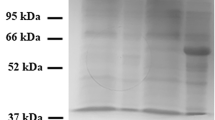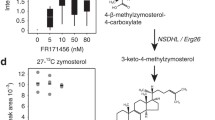Abstract
The enzyme 3-hydroxy-3-methyl-glutaryl CoA reductase (HMGR) is a glycoprotein of the endoplasmic reticulum that participates in the mevalonate pathway, the precursor of cholesterol in human and ergosterol in fungi. This enzyme has three domains: transmembrane, binding, and soluble. In this study, we expressed and purified the soluble fraction of the HMGR enzyme from Candida glabrata (CgHMGR) in an Escherichia coli heterologous system and used it as a model for studying its inhibitory activity. The soluble fraction of CgHMGR was fused to the maltose binding protein (MBP), purified, and characterized. Optimal pH was 8.0, and its optimal temperature activity was 37 °C. The k m and V max for the HMG-CoA were 6.5 μM and 2.26 × 10−3 μM min−1, respectively. Recombinant CgHMGR was inhibited by simvastatin presenting an IC50 at 14.5 μM. In conclusion, our findings suggest that the recombinant HMGR version from C. glabrata may be used as a study model system for HMGR inhibitors such as statins and newly synthesized inhibitor compounds that might be used in the treatment of hypercholesterolemia or mycosis.




Similar content being viewed by others
References
Durr, I. F., & Rudney, H. (1960). The reduction of beta-hydroxy-beta-methyl-glutaryl coenzyme A to mevalonic acid. Journal of Biological Chemistry, 235, 2572–2578.
Burg, J. S., & Espenshade, P. J. (2011). Regulation of HMG-CoA reductase in mammals and yeast. Progress in Lipid Research, 50, 403–410.
Pichandi, S., Pasupathi, P., Raoc, Y. Y., Farook, J., Ambika, A., Ponnusha, B. S., Subramaniyam, S., Virumandy, R., & Subramaniyam, B. (2011). The role of statin drugs in combating cardiovascular diseases. International Journal of Current Science, 1, 47–56.
Aronow, W. S. (2015). Treatment of hypercholesterolemia in 2015. American Journal of Therapeutics. doi:10.1097/MJT.0000000000000358.
Westermayer, C., & Macreadie, I. G. (2007). Simvastatin reduces ergosterol levels, inhibits growth and causes loss of mtDNA in Candida glabrata. FEMS Yeast Research, 7, 436–441.
Bochar, D. A., Stauffacher, C. V., & Rodwell, V. W. (1999). Sequence comparisons reveal two classes of 3-hydroxy-3-methylglutaryl coenzyme A reductase. Molecular Genetics and Metabolism, 66, 122–127.
Friesen, J. A., & Rodwell, V. W. (2004). The 3-hydroxy-3-methylglutaryl coenzyme-A (HMG-CoA) reductases. Genome Biology, 5, 248–254.
Istvan, E. S., & Deisenhofer, J. (2000). The structure of the catalytic portion of human HMG-CoA reductase. Biochimica et Biophysica Acta, 1529, 9–18.
Istvan, E. S., Palnitkar, M., Buchanan, S. K., & Deisenhofer, J. (2000). Crystal structure of the catalytic portion of human HMG-CoA reductase: insights into regulation of activity and catalysis. EMBO Journal, 19, 819–830.
Nash, J. D., Burgess, D. S., & Talbert, R. L. (2002). Effect of fluvastatin and pravastatin, HMG-CoA reductase inhibitors, on fluconazole activity against Candida albicans. Journal of Medical Microbiology, 51, 105–109.
Argüelles, N., Sánchez-Sandoval, E., Mendieta, A., Villa-Tanaca, L., Garduño-Siciliano, L., Jiménez, F., Cruz, M. D. C., Medina-Franco, J. L., Chamorro-Cevallos, G., & Tamariz, J. (2010). Design, synthesis, and docking of highly hypolipidemic agents: Schizosaccharomyces pombe as a new model for evaluating α-asarone-based HMG-CoA reductase inhibitors. Bioorganic & Medicinal Chemistry, 18, 4238–4248.
Andrade-Pavón, D., Sánchez-Sandoval, E., Rosales-Acosta, B., Ibarra, J. A., Tamariz, J., Hernández-Rodríguez, C., & Villa-Tanaca, L. (2014). The 3-hydroxy-3-methylglutaryl coenzyme-A reductases from fungi: a proposal as a therapeutic target and as a study model. Revista Iberoamericana de Micología, 31, 81–85.
Pfaller, M. A., & Diekema, D. J. (2007). Epidemiology of invasive candidiasis: a persistent public health problem. Clinical Microbiology Reviews, 20, 133–163.
Hitchcock, C. A., Pye, G. W., Troke, P. F., Johnson, E. M., & Warnock, D. W. (1993). Fluconazole resistance in Candida glabrata. Antimicrobial Agents and Chemotherapy, 37, 1962–1965.
Hernáez, M. L., Pla, J., & Nombela, C. (1997). Molecular and genetic aspects azole resistance in Candida albicans. Revista Iberoamericana de Micología, 14, 150–154.
Pasqualotto, A. C., & Denning, D. W. (2008). New and emerging treatments for fungal infections. Journal of Antimicrobial Chemotherapy, 61, 19–30.
Dujon, B., Sherman, D., Fischer, G., Durrens, P., Casaregola, S., Lafontaine, I., De Montigny, J., Marck, C., Neuvéglise, C., Talla, E., Goffard, N., Frangeul, L., Aigle, M., Anthouard, V., Babour, A., Barbe, V., Barnay, S., Blanchin, S., Beckerich, J. M., Beyne, E., Bleykasten, C., Boisramé, A., Boyer, J., Cattolico, L., Confanioleri, F., De Daruvar, A., Despons, L., Fabre, E., Fairhead, C., Ferry-Dumazet, H., Groppi, A., Hantraye, F., Hennequin, C., Jauniaux, N., Joyet, P., Kachouri, R., Kerrest, A., Koszul, R., Lemaire, M., Lesur, I., Ma, L., Muller, H., Nicaud, J. M., Nikolski, M., Oztas, S., Ozier-Kalogeropoulos, O., Pellenz, S., Potier, S., Richard, G. F., Straub, M. L., Suleau, A., Swennen, D., Tekaia, F., Wésolowski-Louvel, M., Westhof, E., Wirth, B., Zeniou-Meyer, M., Zivanovic, I., Bolotin-Fukuhara, M., Thierry, A., Bouchier, C., Caudron, B., Scarpelli, C., Gaillardin, C., Weissenbach, J., Wincker, P., & Souciet, J. L. (2004). Genome evolution in yeasts. Nature, 430, 35–44.
Durfee, T., Nelson, R., Baldwin, S., Plunkett 3rd, G., Burland, V., Mau, B., Petrosino, J. F., Qin, X., Muzny, D. M., Ayele, M., Gibbs, R. A., Csörgo, B., Pósfai, G., Weinstock, G. M., & Blattner, F. R. (2008). The complete genome sequence of Escherichia coli DH10B: insights into the biology of a laboratory workhorse. Journal of Bacteriology, 19, 2597–2606.
Grodberg, J., & Dunn, J. J. (1988). OmpT encodes the Escherichia coli outer membrane protease that cleaves T7 RNA polymerase during purification. Journal of Bacteriology, 170, 1245–1253.
Smith, T. F., & Waterman, M. S. (1981). Identification of common molecular subsequences. Journal of Molecular Biology, 147, 195–197.
Sigrist, C. J., de Castro, E., Cerutti, L., Cuche, B. A., Hulo, N., Bridge, A., Bougueleret, L., & Xenarios, I. (2013). New and continuing developments at PROSITE. Nucleic Acids Research, 41, 344–347.
Hirokawa, T., Boon-Chieng, S., & Mitaku, S. (1998). SOSUI: classification and secondary structure prediction system for membrane protein. Bioinformatics, 14, 378–379.
Nakai, K., & Horton, P. (1999). PSORT: a program for detecting the sorting signals of proteins and predicting their subcellular localization. Trends in Biochemical Sciences, 24, 34–35.
Webb, B., & Sali, A. (2014). Comparative protein structure modeling using Modeller. Current Protocols in Bioinformatics, 5(6), 1–5.6.32.
Osipovitch, M., Lambrecht, M., Baker, C., Madha, S., Mills, J. L., Craig, P. A., & Bernstein, H. J. (2015). Automated protein motif generation in the structure-based protein function prediction tool ProMOL. Journal of Structural and Functional Genomics, 16, 101–111.
Green, M. R., & Sambrook, J. (2012). A molecular cloning: a laboratory manual (4th ed.). NJ: Cold Spring Harbor.
Ibarra, J. A., García-Zacarías, C. M., Lara-Ochoa, C., Carabarin-Lima, A., Tecpanecatl-Xihuitl, J. S., Pérez-Rueda, E., Martínez-Laguna, Y., & Puente, J. L. (2013). Further characterization of functional domains of PerA, role of amino and carboxy terminal domains in DNA binding. PloS One, 8, e56977.
Lowry, O. H., Rosebrough, N. J., Farr, A. L., & Randall, R. J. (1951). Protein measurement with the folin phenol reagent. The Journal of Biological Chemistry, 193, 265–275.
Laemmli, U. K. (1970). Cleavage of structural proteins during the assembly of the head of bacteriophage T4. Nature, 227, 351–355.
Bischoff, K. M., & Rodwell, V. W. (1995). 3-Hydroxy-3-methylglutaryl-coenzyme A reductase from Haloferax volcanii: purification, characterization, and expression in Escherichia coli. Journal of Bacteriology, 178, 19–23.
Kleinsek, D. A., Dugan, R. E., Baker, T. A., & Porter, J. W. (1981). 3-hydroxy-3-methylglutaryl-CoA reductase from rat liver. Methods in Enzymology, 71, 462–479.
Bates, R. G. (1964). Determination of pH: theory and practice. NY: Wiley.
Whaley, S. G., & Rogers, P. D. (2016). Azole resistance in Candida glabrata. Current Infectious Disease Reports, 18, 41.
Campoy, S., & Adrio, J. L. (2016). Antifungal. Biochemical Pharmacology. doi:10.1016/j.bcp.2016.11.019.
Mayer, R. J., Debouck, C., & Metcalf, B. W. (1998). Purification and properties of the catalytic domain of human 3-hydroxy-3-methylglutaryl-CoA reductase expressed in Escherichia coli. Archives and Biochemistry and Biophysics, 267, 110–118.
Juárez-Montiel, M., Ibarra, J. A., Chávez-Camarillo, G., Hernández-Rodríguez, C., & Villa-Tanaca, L. (2014). Molecular cloning and heterologous expression in Pichia pastoris of X-prolyl-dipeptidyl aminopeptidase from basidiomycete Ustilago maydis. Applied Biochemistry and Biotechnology, 172, 2530–2539.
Rao, D. V., Ramu, C. T., Rao, J. V., Narasu, M. L., & Rao, A. K. (2009). Cloning, high expression and purification of recombinant human interferon-beta-1b in Escherichia coli. Applied Biochemistry and Biotechnology, 158, 140–154.
Wang, Y., Qian, S., Meng, G., & Zhang, S. (2001). Cloning and expression of L-asparaginase gene in Escherichia coli. Applied Biochemistry and Biotechnology, 95, 93–101.
Brondyk, W. H. (2009). Selecting an appropriate method for expressing a recombinant protein. Methods in Enzymology, 463, 131–147.
Demain, A. L., & Vaishnav, P. (2009). Production of recombinant proteins by microbes and higher organisms. Biotechnology Advances, 27, 297–306.
Croxen, R., Goosey, M. W., Keon, J. P., & Hargreaves, J. A. (1994). Isolation of an Ustilago maydis gene encoding 3-hydroxy-3-methylglutaryl-coenzyme reductase and expression of C-terminal-truncated forms in Escherichia coli. Microbiology, 140, 2363–2370.
Theivagt, A. E., Amanti, E. N., Beresford, N. J., Tabernero, L., & Friesen, J. A. (2006). Characterization of an HMG-CoA reductase from Listeria monocytogenes that exhibits dual coenzyme specificity. Biochemistry, 45, 14397–14406.
Takahashi, S., Kuzuyama, T., & Seto, H. (1999). Purification, characterization and cloning of a eubacterial 3-hydroxy-3-methylglutaryl coenzyme A reductase, a key enzyme involved in biosynthesis of terpenoids. Journal of Bacteriology, 181, 256–263.
Hurtado-Guerrero, R., Peña-Díaz, J., Montalvetti, A., Ruiz-Pérez, L. M., & González-Pacanowska, D. (2002). Kinetic properties and inhibition of Trypanosoma cruzi 3-hydroxy-3-methylglutaryl CoA reductase. FEBS Letters, 510, 141–144.
Istvan, E. S., & Deisenhofer, J. (2001). Structural mechanism for statin inhibition of HMG-CoA reductase. Science, 292, 1160–1164.
Pedersen, T. R., & Tobert, J. A. (2004). Simvastatin: a review. Expert of Opinion on Pharmacotherapy, 5, 2583–2596.
Mendieta, A., Jiménez, F., Garduño-Siciliano, L., Mojica-Villegas, A., Rosales-Acosta, B., Villa-Tanaca, L., Chamorro-Cevallos, G., Medina-Franco, J. L., Meurice, N., Gutiérrez, R. U., Montiel, L. E., Cruz Mdel, C., & Tamariz, J. (2014). Synthesis and highly potent hypolipidemic activity of alpha-asarone- and fibrate-based 2-acyl and 2-alkyl phenols as HMG-CoA reductase inhibitors. Bioorganic & Medicinal Chemistry, 22, 5871–5882.
Chin, N. X., Weitzman, I., & Della-Latta, P. (1997). In vitro activity of fluvastatin, a cholesterol-lowering agent, and synergy with fluconazole and itraconazole against Candida species and Cryptococcus neoformans. Antimicrobial Agents and Chemotherapy, 41, 850–852.
Nyilasi, I., Kocsubé, S., Pesti, M., Lukács, G., Papp, T., & Vágvölgyi, C. (2010a). In vitro interactions between primycin and different statins in their effects against some clinically important fungi. Journal of Medical Microbiology, 59, 200–205.
Nyilasi, I., Kocsubé, S., & Krizsán, K. (2010b). In vitro synergistic interactions of the effects of various statins and azoles against some clinically important fungi. FEMS Microbiology Letters, 307, 175–184.
Singh, S., Dinesh, N., Kaur, P. K., & Shamiulla, B. (2014). Ketanserin, an antidepressant, exerts its antileishmanial action via inhibition of 3-hydroxy-3-methylglutaryl coenzyme A reductase (HMGR) enzyme of Leishmania donovani. Parasitology Research, 113, 2161–2168.
Chen, J. B., Chern, T. R., Wei, T. T., Chen, C. C., Lin, J. H., & Fang, J. M. (2013). Design and synthesis of dual-action inhibitors targeting histone deacetylases and 3-hydroxy-3-methylglutaryl coenzyme A reductase for cancer treatment. Journal of Medical Chemistry, 56, 3645–3655.
Acknowledgments
The authors would like to thank Dr. Yuridia Mercado for helpful technical advice. Dr. Ravi Pathak is very much appreciated for proofreading this manuscript.
Author information
Authors and Affiliations
Corresponding authors
Ethics declarations
Funding
This work was supported by CONACYT [133695] and SIP-IPN [20161403, 20161245; 20150981 and 20150612]. DMA-P and RIC-H were recipients of fellowships from CONACyT and BEIFI-IPN. JAI, CHR, and LVT received support from COFAA-IPN, EDI-IPN, and SNI CONACyT. JAI and LVT were hired through “Programa Institucional de Contratación de Personal Académico de Excelencia (PICPAE) IPN.”
Conflict of Interest
The authors declare that they have no conflict of interest.
Electronic supplementary material
ESM 1
(DOCX 367 kb)
Rights and permissions
About this article
Cite this article
Andrade-Pavón, D., Cuevas-Hernández, R.I., Trujillo-Ferrara, J.G. et al. Recombinant 3-Hydroxy 3-Methyl Glutaryl-CoA Reductase from Candida glabrata (Rec-CgHMGR) Obtained by Heterologous Expression, as a Novel Therapeutic Target Model for Testing Synthetic Drugs. Appl Biochem Biotechnol 182, 1478–1490 (2017). https://doi.org/10.1007/s12010-017-2412-9
Received:
Accepted:
Published:
Issue Date:
DOI: https://doi.org/10.1007/s12010-017-2412-9




